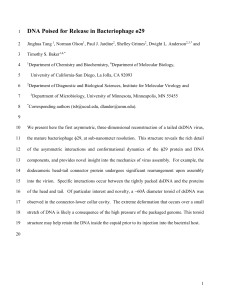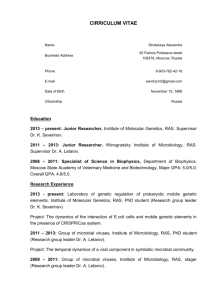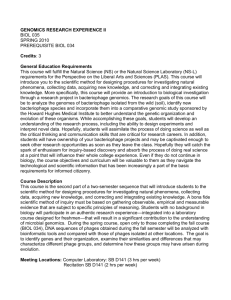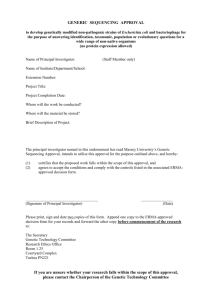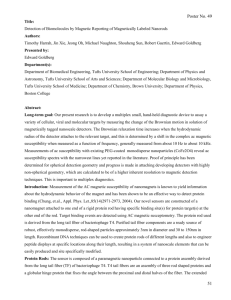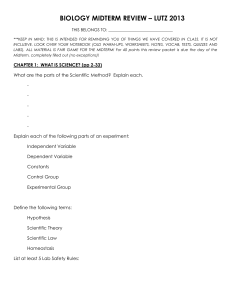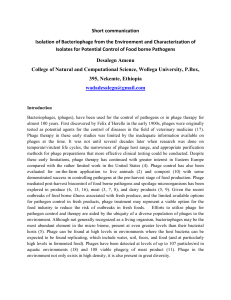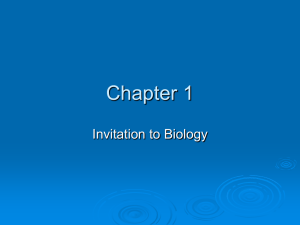Phage therapyjsfinaldraft 1 - You have reached the Pure
advertisement
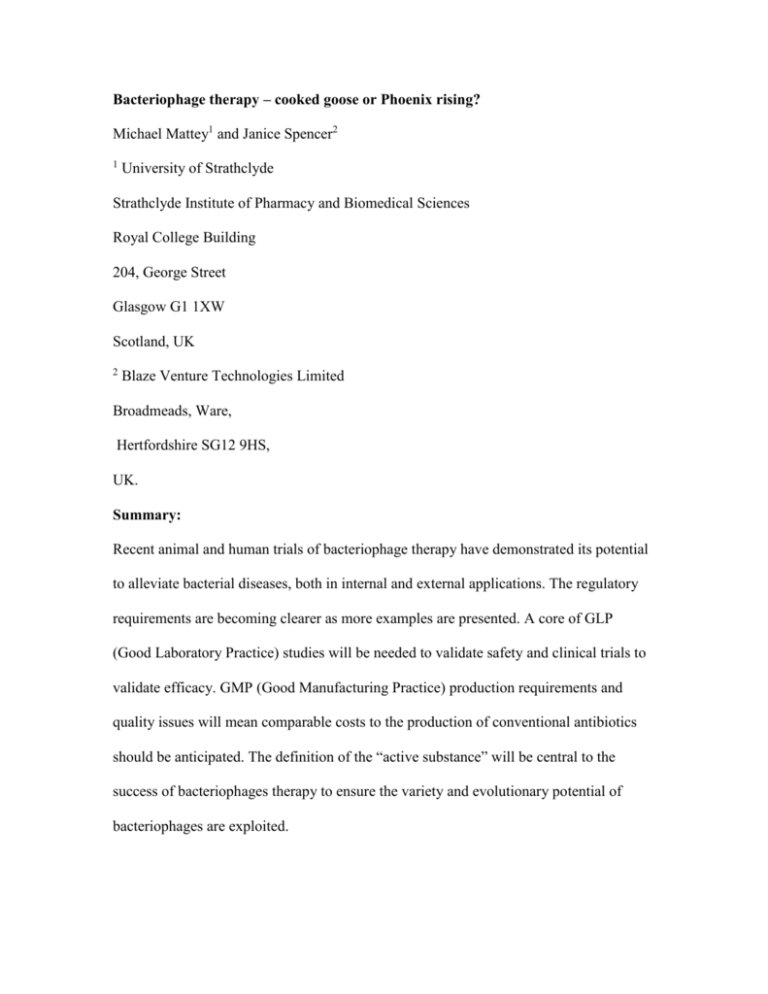
Bacteriophage therapy – cooked goose or Phoenix rising? Michael Mattey1 and Janice Spencer2 1 University of Strathclyde Strathclyde Institute of Pharmacy and Biomedical Sciences Royal College Building 204, George Street Glasgow G1 1XW Scotland, UK 2 Blaze Venture Technologies Limited Broadmeads, Ware, Hertfordshire SG12 9HS, UK. Summary: Recent animal and human trials of bacteriophage therapy have demonstrated its potential to alleviate bacterial diseases, both in internal and external applications. The regulatory requirements are becoming clearer as more examples are presented. A core of GLP (Good Laboratory Practice) studies will be needed to validate safety and clinical trials to validate efficacy. GMP (Good Manufacturing Practice) production requirements and quality issues will mean comparable costs to the production of conventional antibiotics should be anticipated. The definition of the “active substance” will be central to the success of bacteriophages therapy to ensure the variety and evolutionary potential of bacteriophages are exploited. Bacteriophage therapy Introduction: Bacteria evolved long before humans appeared and we have co-existed with them throughout our own evolution. The bacterial disease that infected our ancient ancestors, tuberculosis, leprosy, plague, cholera, typhoid, and typhus still cause deaths today. The “Black Death” of 1347 killed about 25 million people in Europe in 5 years, which was between a quarter and half the population. Even now, with antibiotics widely available, a proportion of the 3.9 million deaths from pneumonia each year are bacterial, while tuberculosis kills about 1.6 million and diarrhoeal diseases account for another 1.6 million. Since the start of antibiotic treatment in the 1940’s bacterial infections resistant to antibiotics have increased and over the past few years have swamped health services with difficult to treat and manage infections. This has lead to increased hospital stays, costs and mortality. The Arabic physician Avicenna, in the early 11th century, is often credited with discovering the contagious nature of diseases and he introduced the concept of quarantine as a means of limiting the spread of disease. [1], a concept reflected in the successful use of individual isolation rooms for patients with hospital acquired infections. Treatments for bacterial and other diseases were historically based on plants, animal or inorganic materials although fungal antibiotics were unknowingly employed. Equally, bacteriophages were probably utilised; the practice of drinking natural “holy waters” to cure “consumption” and other diseases, the concept of baptism by immersion, originally in rivers (Jordon and Ganges!), leading to “miracle cures” may have a rational basis in bacteriophages. Mud (a source of adsorbed bacteriophages) or clay poultices have long been used for skin complaints, the earliest record dates from the last quarter of the third 2 Bacteriophage therapy millennium BC; prescription 5 of a medical cuneiform tablet reads “Pulverise river mud and..…knead it with water; rub with crude oil and fasten as a poultice.” [2]. Microorganisms have contested resources for billions of years, bacteria appeared about 4000 Myr ago and their viruses, bacteriophages, may have evolved soon after as part of the bacterial struggle for resources, with a virus that infected a competitor being advantageous. Antibiotics were a later fungal or bacterial weapon, their producers appearing as recently as 1000Myr. When we ask the question “antibiotic or bacteriophage therapy?” we seek to utilise the weapons of a very ancient war. History of bacteriophages: Bacteriophages were officially discovered by Felix d’Herelle in 1917, a French-Canadian microbiologist at the Institut Pasteur in Paris, but the existence of bacteriophage was hypothesised by Frederick Twort a few years earlier [3]. The subsequent history of success, failure and politics has been extensively reviewed [4 -18]. Microbiology: Bacteriophages constitute a group of viruses with the ability to invade various bacterial species as their specific hosts. They are widespread in nature and are known to attack over 140 bacterial or archaeal genera. Moreover, bacteriophages are universally observed in open and coastal waters, marine sediments, terrestrial ecosystems such as soil, and the bodies of humans, animals, and insects [19]. Their presence has been detected in faeces [20], saliva [21, 22], human and bovine serum and they are known to be in high abundance in aquatic environments [23]; non-polluted water contains 2 x 108 bacteriophages per ml. It is thought that for each individual bacterial cell there are ten bacteriophage particles [12]. 3 Bacteriophage therapy According to the International Committee on Taxonomy (ICTV), bacteriophage can be divided into 13 families and 30 genera, each with a variety of distinguishing characteristics, such as size, nature of genetic material and appearance. The “mosaic concept” suggests that each bacteriophage is defined by its own set of properties based on related genetic elements [19]. The majority of bacteriophages contain dsDNA, although a minority contain ssDNA, ssRNA, or dsRNA. Once a bacteriophage has infected the host cell, the resultant infection may be either lytic, reprogramming and soon destroying the infected cell, or lysogenic, where the bacteriophage genome is integrated into the bacterial genome and passed on to future generations of bacteria. Lytic bacteriophages are used for most therapeutic approaches. A typical lytic bacteriophage will produce 100-300 new bacteriophages from an infected bacterial cell in a matter of hours. These can go on to infect and kill a new generation of the target bacteria. Exponential replication only stops when the bacteriophages run out of target bacteria. Without their target, they are simply small lumps of protein, potential nutrients for other microorganisms, which would be removed from humans by the normal clearance processes of the body. Bacteriophage Therapy, what is it? Therapy is simply the medical treatment of disease so that bacteriophage therapy covers a wide range from the treatment of external and internal bacterial infections with intact natural bacteriophages or genetically modified bacteriophages [24] to the use of bacteriophage components [25]. This article covers only the use of natural intact bacteriophages. 4 Bacteriophage therapy Bacteriophage therapy vs. chemotherapy Almost every review on bacteriophage therapy cites a number of “advantages” of bacteriophages over antibiotics but most such reviews are written by proponents of bacteriophage therapy. Over optimism that is not supported by clinical evidence and undue pessimism or conspiracy theories are not helpful. The introduction of bacteriophage therapy will require a combination of efficacy and commercial value and the present situation in much of the world is that antibiotic treatment is the only therapy available. To displace a dominant product in any market requires a medium to long term strategy, a rapid displacement is unlikely. The experience of bacteriophage therapy in a command economy such as that existing in Eastern Europe until recently is not a useful model; regulatory requirements and cost effectiveness will not be waived because bacteriophages are different from the products of the chemical industry. Advantage one: “Bacteriophages only kill harmful pathogens”. The specificity of bacteriophages varies from a few extremely selective bacteriophages, often used in bacteriophage typing of bacteria, to relatively broad specificity bacteriophages, but none have the breadth of action of antibiotics. This is indeed advantageous in that unrelated bacteria are not killed by bacteriophages, so that for example, gut bacterial flora are not unnecessarily disrupted by therapy, but is a lot less relevant in septacaemia when the presence of any bacteria is undesirable. Where a bacterial infection is acute a broad spectrum antibiotic must be the clinical choice for rapid treatment but for chronic infection, where antibiotics have failed to eliminate the infection and the patient is still alive, then bacteriophages may have a role. 5 Bacteriophage therapy Although much has been written, particularly in the media, about the end of the antibiotic era, it is likely that antibiotics will continue to be the first line treatment for the near and mid term future. It is worth noting that antibiotic resistance rarely exceeds 70% of the clinical isolates which suggests that the evolutionary pressures towards specific antibiotic resistance is countered by other factors. Since the mode of action of bacteriophages is different to that of any antibiotic the ability of bacteriophages to relieve or counter the evolutionary pressure of antibiotics on bacteria must count as an advantage. Advantage two: “Bacteriophages are active against antibiotic resistant bacteria” How much of a problem antibiotic resistance is depends on where you are. In the Netherlands and Scandinavian countries the incidence of MRSA in hospitals is low (<1%) [26] thanks to a “seek and destroy” policy, while in the USA and UK the incidence of MRSA is much higher at around 42% [27]. This situation may well change with the increase in community acquired resistance and increasing numbers of species developing resistance. Bacteriophage could be an answer to the problem as they have a totally different killing mechanism to antibiotics and they will evolve to meet whatever changes occur in bacteria. On the negative side bacterial resistance to bacteriophages does arise with a similar frequency to that of antibiotic resistance [28] which will incur a cost in isolating appropriate new variants, which may not be as easy as sometimes assumed, and cost in regulatory approval for the new strains used. Advantage three: “Bacteriophages are safe and cheap and easy to produce” The limited trials evidence, animal studies and anecdotal evidence all agree that bacteriophages are “low risk” although lysogenic bacteriophages, ones with toxin or virulence sequences or genetically engineered bacteriophages will be scrutinised more 6 Bacteriophage therapy closely by regulators. The likelihood is that regulatory requirement can be readily met, but the evidence will have to be produced with GLP data. Exactly how regulators will view bacteriophages, given the impossibility of a “species” definition, is not clear; a single bacteriophage or cocktail of bacteriophages could be defined on the basis of, say, gene sequence, but given the cost of the regulatory process, the necessity of changing the bacteriophages regularly to counteract bacterial resistance and the limited market that may exist for bacteriophage therapeutic products, such a limited approval could stop the commercial development of bacteriophage therapeutics. The cost of bringing a typical antibiotic to market is estimated at between $400 to $800 million [29] most of that being regulatory, particularly the phase three clinical trial. Costs for a bacteriophage therapeutic are unlikely to be less for clinical trials. Efficacy of external bacteriophage treatments: Wounds Markoishvili et al [30] showed that bacteriophages soaked into a biodegradable film healed ulcers in 70% of 96 patients. These ulcers had not been healed by conventional treatment. Microbiological assessment was only available from 22 of the patients where healing was associated with elimination of the pathogen from the wound. The dressing also contained the antibiotic ciprofloxacin and bacteriophages commercially known as ‘PyoPhage’ active against strains of Pseudomonas aeruginosa, Escherichia coli, Staphylococcus aureus, Streptococcus and Proteus. The healing of these wounds could not be solely attributed to the bacteriophage. 7 Bacteriophage therapy Soothill [31] reported that skin grafts infected by P. aeruginosa consistently failed in a guinea pig model. When these infected grafts were treated with 106 pfu of specific bacteriophage, 6 out of 7 grafts took. Soothill and colleagues also demonstrated efficacy with a bacteriophage against S. aureus in a rabbit abscess model [32]. The sewerage derived bacteriophage reduced the abscess area and the count of S. aureus in the abscess in a bacteriophage-dose dependant way. Recent studies have reported that 87% of mice administered with a lethal dose of P. aeruginosa in a mouse burn model were protected by a single dose of bacteriophage cocktail injected intraperitoneally [33]. Capparelli et al [34] showed that bacteriophage against S. aureus could prevent abscess formation and reduce the bacterial load and weight of abscesses when S. aureus was injected into the flanks of mice. Gut A study by Smith et al [35] demonstrated that bacteriophage could cure severe diarrhoea caused by an enteropathogenic E. coli (EPEC) strain in calves. The single dose of bacteriophage was given at the same as the bacteria. Other cows that were feeding on litter contaminated by these bacteriophage infected cows were protected against the diarrhoea as well. This study showed the importance of matching the bacteriophage against the EPEC strain inoculated, there was also the presence of bacteriophages- resistant EPEC strains which were as virulent as the original strain. 8 Bacteriophage therapy Recently Watanabe et al [36] showed that oral administration of bacteriophages was effective in 66.7% of mice in a murine model of gut derived sepsis caused by P. aeruginosa. Ears Marza et al [37] reported treatment of a dog with chronic bilateral otitis external that had consistently grown P. aeruginosa. This infection had failed to be resolved after repeated courses of topical and systemic antibiotics. After inoculation with 400pfu of bacteriophage into the auditory canal there was marked improvement in the clinical signs, 27 hr after treatment. At a recent conference it was revealed that a human trial of a bacteriophage cocktail against P. aeruginosa has been successful in treating patients with chronic ear infections. The trial was carried out in a specialised central London hospital and was carefully devised with a double blind study and finished in November 2007; publications are in preparation (www.biocontrol-ltd.com). Internal Bacteriophage therapy: The treatment of systemic infections is the most challenging environment for bacteriophage action, with issues of compartmentation, host defense and kinetics, which are not present to the same degree in topical applications, creating real or imaginary barriers. 9 Bacteriophage therapy There are three aspects to consider when evaluating bacteriophage therapy; the comparison with existing antibiotic treatments, the efficacy of bacteriophage treatment and the cost to benefit of the treatment. Trials of bacteriophage therapy in humans has been limited to studies in Eastern Europe and Russia. Reviews of the Soviet literature [38, 39, 14] indicate a high level of success for various forms of bacteriophage therapy, mostly oral bacteriophage delivery for dysentery or local treatment of wounds. Slopek et al [40] reported bacteriophage treatment of septacaemia with a 90% success rate but such trials have not been sufficiently rigorous to be of regulatory usefulness. What is clear from such work is that bacteriophage therapy has potential in the treatment of acute or chronic infections but well designed trials are needed to validate this claim. Animal trials of injected bacteriophages have been carried out in a number of species with encouraging results. Intramuscular injection of lytic bacteriophages was used to treat experimental E. coli septicemia in chickens and calves [41]. Chickens given equal doses of bacteriophage and bacteria showed no morbidity, significant protection was shown by 1% bacteriophage/ bacteria doses, indicating bacteriophage multiplication in vivo. With calves, intramuscular injection of bacteriophages delayed the onset of an experimental infection of E. coli and increased survival times. Mouse models of bacterial infection have had some success; a significant study on vancomycin-resistant Enterococcus faecium (VRE) infection [42] demonstrated that intraperitoneal administration of bacteriophages isolated from sewage against VRE- E faecium prevented death. 10 Bacteriophage therapy When given 45 minutes after infection the bacteriophages prevented bacteraemia with a reduction in circulating bacteria. Fully effective treatment was observed up to five hours after infection, but was less effective beyond this time. The kinetics of bacteriophages in model situations has been examined [43,44]; the outcome of treatment with a self replicating agent such as bacteriophages was shown to depend critically on the initial numbers and replication rates of both the bacteriophages and their bacterial hosts. Descriptions of their interactions follow a predator – prey relationship rather than classical pharmacokinetics. Smith and Huggins [45] showed that bacteriophage lytic for an E. coli strain (O18:K1:H7) which causes generalised infections in both man and animals was more effective than conventional antibiotics in a mouse model. The E. coli strain was injected intracerebrally into groups of 32 mice. At the same time the mice were either injected with a single dose of anti-K1 bacteriophage intramuscularly or by multiple intramuscular doses of antibiotics (streptomycin, tetracycline, ampicillin, chloramphenicol or trimethoprim-sulfafurazole. In controls (no, bacteriophage or antibiotics), 31 out of 32 mice died, The lowest death rate noticed was in the bacteriophage treated group, in which 13 mice died. The antibiotic treated mice fared worse with 18 mice dying in the streptomycin treated group and 26-28 dying in all the other antibiotic treated groups. Further observations were that bacteriophage resistant strains of E. coli were isolated from the bacteriophage treated group. This E. coli strain did not produce any K1 capsule, according to the failure to precipitate anti-K1 antiserum on agar. Previous studies have shown than K1 mutants had greatly reduced virulence when injected into mice or chickens due to their inability to invade tissues [46]. 11 Bacteriophage therapy Soothill [47] reported the protective ability of bacteriophages lytic against strains of Acinetobacter baumanii, P. aeruginosa and S. aureus in experimental infections of mice to investigate their potential for the treatment of infections of man. As few as 102 particles of an Acinetobacter bacteriophage protected mice against five times the LD50 (1 x 108 cfu) of a virulent strain of A. baumanii, and the bacteriophages multiplied in the mice. A Pseudomonas bacteriophage protected mice against five times the LD50 of a virulent strain of P. aeruginosa, with a PD50 of 1.2 x 107particles. A Staphylococcal bacteriophage failed to protect mice infected with a strain of S. aureus. Another failure was reported by Skurnik [11]. Capparelli et al [34] reported that that 109 pfu of bacteriophage against S. aureus was protective against a lethal dose of S. aureus in 97% of mice when administered with the bacteria. The group also reported that mice infected intravenously with the lowest dose of S. aureus strain not cleared by the innate immune system could be cleared of the bacterial infection by giving the mice a single dose of bacteriophage (109 pfu) 10 days after initial bacterial infection. Conclusions. These studies support the view that bacteriophages could be useful in the treatment of human infections particularly those caused by antibiotic-resistant strains of bacteria but that they are not a “miracle cure”. Assuming that the efficacy of bacteriophage treatment is similar to that of antibiotics (and it is worth remembering that antibiotics are not 100% effective even with sensitive bacteria!) then the availability of bacteriophage therapy will depend on sensible and appropriate regulation and realistic business plans. 12 Bacteriophage therapy Acknowledgements: The authors would like to thank Fiona Holland for some material used in this review. Potential conflict of interest: Both authors are associated (MM) or employed (JS) by Blaze v-t. This company uses bacteriophages non clinically and is not involved in bacteriophages therapy, so no conflict of interest is perceived. Ref 1. Tschanz D: Arab Roots of European Medicine. Heart Views 2003, 2:4. 2. Civil M: Revue d’Assyriologie. LIV 1960: 59 – 72. 3. Twort F: An investigation on the nature of ultramicroscopic viruses. Lancet 1915 ii: 1241. 4. Bradbury J. My enemy’s enemy is my friend. Using phages to fight bacteria. Lancet 2005, 363: 624-625. 5. Brussow H: Phage therapy: the Escherichia coli experience. Microbiology 2005, 151:2133 - 2140. 6. Clewley J: The day of the phage. Commun. Dis. Public Health 2003, 6:260- 262. 7. Duckworth D, Gulig P: Bacteriophage. Potential treatment for bacterial infections. Biodrugs 2002, 16:57-62. 8. Inal J: Phage therapy: a reappraisal of bacteriophages as antibiotic. Arch. Immun. Ther. Exp 2003, 51:237-244. 13 Bacteriophage therapy 9. Matsuzaki S, Rashel M, Uchiyama J, Sakurai S, Ujihara T, Kuroda M, Ikeuchi M, Tani T, Fujieda M, Wakiguchi H, Imai S: Bacteriophage therapy: a revitalised therapy against bacterial infectious diseases. J. Inf. Chemother 2005, 11:211-219. 10. Merril C, Scholl D, Adhya S: The prospect of bacteriophage therapy in Western medicine. Nat. Rev. Drug Discov 2003, 2:489-497. 11. Parfitt T. Georgia: an unlikely stronghold for bacteriophage therapy. Lancet 2005, 365:2166-2167. 12. Skurnik M, Strauch E: Phage therapy: facts and fiction: Int J Med Microbiol 2006, 296:5-14. 13. Stone R: Stalin’s forgotten cure. Science 2002, 298:728-731. 14. Sulakvelidze A, Alavidze Z, Morris J: Bacteriophage therapy. Antimicrob. Agents Chemother 2001, 45:649-659. 15. Sulakvelidze A: Phage therapy: an attractive option for dealing with antibioticresistant infections. Drug Discover Today 2005, 10: 807-809. 16. Summers W: Bacteriophage therapy. Ann Rev Microbiol 2001, 55: 437-51. 17. Thacker P: Set a microbe to kill a microbe. Drug resistance renews interest in phage therapy. JAMA 2003, 290:3183-3185. 18. Thiel K: Old dogma, new tricks – 21st century phage therapy. Nature Biotechnol 2004, 22:31-36. 19. Ackermann H: Bacteriophage observations and evolution. Research in Microbiol. 2003, 154:245-251. 14 Bacteriophage therapy 20. Breitbart M, Felts B, Kelly S, Mahaffy J, Nulton J, Salamon P, Rohwer F: Diversity and population structure of a near-shore marine-sediment viral community. Proc. Biol. Sci. 2004, 271:565-574. 21. Bachrach G, Leizerovici-Zigmond M, Zlotkin A, Naor R, Steinberg D: Bacteriophage isolation from human saliva Lett. Appl. Microbiol. 2003, 36:50- 53. 22. Hitch G, Pratten J, Taylor P: Isolation of bacteriophages from the oral cavity. Lett. Appl. Microbiol. 2004, 39:215-219. 23. Bergh O, Borsgeim G, Bratbak S, Heldal M: High abundance of viruses found in aquatic environments. Nature Journal 1989, 340:467-468. 24. Westwater C, Kasman LM, Schofield DA, Werner PA, Dolan JW, Schmidt MG, Norris JS. Use of genetically engineered phage to deliver antimicrobial agents to bacteria: an alternative therapy for treatment of bacterial infections. Antimicrob Agents Chemother 2003, 47:1301-7. 25. Fischetti V, Nelson D, Schuch R: Reinventing phage therapy: are the parts greater than the sum? Nature Biotech 2006, 24:1508 – 1511. Reviews the development of lysins as antibacterial agents in agricultural and food biotechnology. 26. EARSS Annual report 2006: On-going surveillance of S.pneumoniae, S. aureus, E. coli, E. faecium, E. faecalis, K. pneumoniae,P. aeruginosa. ISBN-13: 978-90-6960183-0. 27. Gould I: MRSA bacteraemia. Internat J Antimicrobial. Agents 2007, 30S:S66-S70. 28. Carlton R, Phage Therapy: Past History and Future Prospects. 1999, 47:267-274 15 Bacteriophage therapy 29. Hanlon G: Careful approach needed for bacteriophage therapy. The clinical Services Journal, 2005: 65 – 69 30. Markoishvili K, Tsitlanadze G, Katsarava R, Morris G, Sulakvelidze A: A novel sustained-release matrix bacsed on biodegradable poly(ester amide)s and impregnated with bacteriophages and an antibiotic shows promise in management of infected venous stasis ulcers and other poorly healing wounds. Internat J Dermat 2002, 41:453-458. 31. Soothill J: Bacteriophage prevents destruction of skin grafts by Pseudomonas aeruginosa. Burns 1994, 20:209-211. 32. Wills Q, Kerrigan C, Soothill J. Experimental bacteriophage protection against Staphylococcus aureus abscesses in a rabbit model. Antimicrobial Agents Chemother 2005, 49: 1220-1221. 33. McVay C, Velásquez M. Fralick J. Phage therapy of Pseudomonas aeruginosa infection in a mouse burn wound model. Antimicrobial Agents and Chemotherapy 2007, 51: 1934-1938. Mice treated with a three phage cocktail administered by different routes showed a significant decrease in mortality. Pharmacokinetics suggested the intraperitoneal route gave the highest dose response. 34. Capparelli R, Parlato M, Borriello G, Salvatore P. Iannelli D: Experimental phage therapy against Staphylococcus aureus in mice. Antimicrob Agents Chemother 2007, 51:2765-2773. Describes bacteriophage rescue of mice infected with Staphylococcus aureus where 16 Bacteriophage therapy both lethal and non lethal infections were cleared in 97% of the mice. Phages inside macrophages killed intracellular S. aureus and abscesses were prevented 35. Smith H, Huggins B: The control of experimental Escherichia coli diarrhea in calves and in their environment. J Gen Micro 1987, 133:1127-1135. 36. Watanabe R, Matsumoto T, Sano G, Ishii Y, Tateda K, Sumiyama Y, Uchiyama J, Sakurai S, Matsuzaki S, Imai S, Yamaguchi K: Efficacy of bacteriophage therapy against gut-derived sepsis caused by Pseudomonas aeruginosa in mice. Antimicrob Agents Chemother 2007, 51:446-452. Oral administration decreased the load of Pseudomonas aeruginosa in the gut. Survival rates of 0% for untreated and 67% for treated animals with lower inflammatory cytokines were seen. 37. Marza J, Soothill J, Boydell P, Collyns T: Multiplication of therapeutically administered bacteriophages in Pseudomonas aeruginosa infected patients. Burns 2006, 32:644-646. Describes a clinical case report for the successful bacteriophage treatment of a Pseudomonas aeruginosa infected wound in a 27 year old man and the treatment of a dog with chronic bilateral otitis externa, both infections were resistant to antibiotics. 38. Alisky J, Iczkowski K, Rapoport A, Troitsky N: Bacteriophages show promise as antimicrobial agents. J. Infect 1998, 36:5-15. 39. Sulakvelidze A, Kutter E. Bacteriophage therapy in humans. In Bacteriophages Biology and Applications ed. Sulakvelidze, A. and Kutter, E, 2005. p. 510. Boca Raton, FL: CRC Press. 17 Bacteriophage therapy 40. Slopek S, Weber-Dabrowska M, Dabrowski M, Kucharewicz-Kurukowska A: Results of bacteriophages treatment of supurative bacterial infections in the years 1981- 1986. Arch Immunol Ther Exp 1987, 35:569-583. 41. Barrow P, Lovell M, Berchieri A: Use of Lytic Bacteriophage for Control of Experimental Escherichia coli Septicemia and Meningitis in Chickens and Calves. Clin Diagnostic Lab Immun.1998, 5: 294-298. 42. Biswas B, Adhya S, Washart P, Paul B, Trostel A, Powell B, Carlton R, Merril C: Bacteriophage therapy rescues mice bacteremic from a clinical isolate of vancomycin-resistant Enterococcus faecium. Infect. Immun 2002, 70:204-210. 43. Payne RJH. and Jansen VAA: Phage Therapy: The peculiar kinetics of self replicating pharmaceuticals. Clin. Pharm.& Ther. 2000, 68 3:225-230 44. Levin BR. And Bull JJ: Population and evolutionary dynamics of phage therapy. Nature Rev. Micro. 2004, 2:166-173 45. Smith H, Huggins B: Successful treatment of experimental Escherichia coli infections in mice using phage; its general superiority over antibiotics. J Gen Micro 1982, 128:307-318. 46. Smith H, Huggins B: The association of the O18 K1 and H7 antigens and the ColV plasmid of a strain of Escherichia coli with its virulence and immunogenicity. J Gen Micro 1980: 121:387- 400. 47. Soothill J: Treatment of experimental infections of mice with bacteriophages. Journal of Medical Microbiology 1992, 37:258-261. 18
